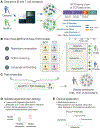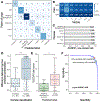Disease diagnostics using machine learning of B cell and T cell receptor sequences
- PMID: 39977494
- PMCID: PMC12061481
- DOI: 10.1126/science.adp2407
Disease diagnostics using machine learning of B cell and T cell receptor sequences
Abstract
Clinical diagnosis typically incorporates physical examination, patient history, various laboratory tests, and imaging studies but makes limited use of the human immune system's own record of antigen exposures encoded by receptors on B cells and T cells. We analyzed immune receptor datasets from 593 individuals to develop MAchine Learning for Immunological Diagnosis, an interpretive framework to screen for multiple illnesses simultaneously or precisely test for one condition. This approach detects specific infections, autoimmune disorders, vaccine responses, and disease severity differences. Human-interpretable features of the model recapitulate known immune responses to severe acute respiratory syndrome coronavirus 2, influenza, and human immunodeficiency virus, highlight antigen-specific receptors, and reveal distinct characteristics of systemic lupus erythematosus and type-1 diabetes autoreactivity. This analysis framework has broad potential for scientific and clinical interpretation of immune responses.
Figures




Update of
-
Disease diagnostics using machine learning of immune receptors.bioRxiv [Preprint]. 2024 Apr 3:2022.04.26.489314. doi: 10.1101/2022.04.26.489314. bioRxiv. 2024. Update in: Science. 2025 Feb 21;387(6736):eadp2407. doi: 10.1126/science.adp2407. PMID: 35547855 Free PMC article. Updated. Preprint.
References
-
- Charlton CL, Babady E, Ginocchio CC, Hatchette TF, Jerris RC, Li Y, Loeffelholz M, McCarter YS, Miller MB, Novak-Weekley S, Schuetz AN, Tang Y-W, Widen R, Drews SJ, Practical Guidance for Clinical Microbiology Laboratories: Viruses Causing Acute Respiratory Tract Infections. Clin. Microbiol. Rev 32 (2019). - PMC - PubMed
-
- Milo R, Miller A, Revised diagnostic criteria of multiple sclerosis. Autoimmun. Rev 13, 518–524 (2014). - PubMed
-
- Kavanaugh A, Tomar R, Reveille J, Solomon DH, Homburger HA, Guidelines for clinical use of the antinuclear antibody test and tests for specific autoantibodies to nuclear antigens. Arch. Pathol. Lab. Med 124, 71–81 (2000). - PubMed
-
- Nielsen SCA, Boyd SD, Human adaptive immune receptor repertoire analysis-Past, present, and future. Immunol. Rev 284, 9–23 (2018). - PubMed
MeSH terms
Substances
Grants and funding
- R01 AI137272/AI/NIAID NIH HHS/United States
- U54 CA260517/CA/NCI NIH HHS/United States
- UM1 AI144292/AI/NIAID NIH HHS/United States
- U19 AI057229/AI/NIAID NIH HHS/United States
- U24 AI086037/AI/NIAID NIH HHS/United States
- P30 AR073750/AR/NIAMS NIH HHS/United States
- R01 AI153133/AI/NIAID NIH HHS/United States
- R01 AI127877/AI/NIAID NIH HHS/United States
- R18 AI048693/AI/NIAID NIH HHS/United States
- P30 DK116074/DK/NIDDK NIH HHS/United States
- R21 AI101093/AI/NIAID NIH HHS/United States
- R01 AI130398/AI/NIAID NIH HHS/United States
- U19 AI167903/AI/NIAID NIH HHS/United States
- UM1 AI144371/AI/NIAID NIH HHS/United States
- R01 CA264090/CA/NCI NIH HHS/United States
- UM1 AI100645/AI/NIAID NIH HHS/United States
- R01 GM134483/GM/NIGMS NIH HHS/United States
- R01 EB001988/EB/NIBIB NIH HHS/United States
- R01 AI175771/AI/NIAID NIH HHS/United States
- 75N93021C00015/AI/NIAID NIH HHS/United States
LinkOut - more resources
Full Text Sources
Medical

